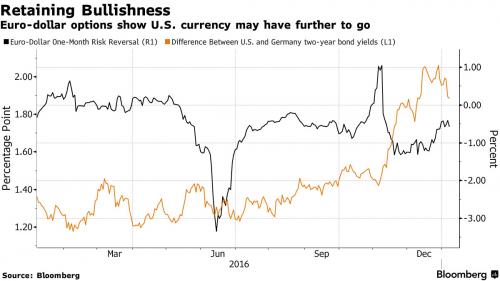European shares fell modestly, Asian equities declined for the first day in three, and US equity futures were unchanged before the December U.S. nonfarm payrolls report. China’s offshore yuan fell the most in a year to pare a record weekly rally, while Mexico’s peso climbed after the central bank sold dollars. Oil was trading lower in early trading.
The main economic event on the financial calendar is today’s 8:30am ET December payroll report. The market consensus for today’s print is 178k which is in line with the 178k in November. It’s worth noting that there’s a reasonable range between economists though with the low forecast at 125k and the high forecast at 221k. DB’s Joe LaVorgna is at the lower end of the range and has pegged a 150k print which is more or less where yesterday’s ADP private employment survey came in at for December (153k vs. 175k expected). What might be more interesting though is whether or not the drop in the unemployment rate is sustained. As a reminder the U3 rate fell to 4.6% in November and the lowest since 2007 from 4.9% in October. The drop has been a focus for Fed officials with more talking about an undershooting of the longer run rate so it is worth watching. As always also keep an eye on average hourly earnings. The consensus is for a +0.3% mom rise in December which would have the effect of pushing the annual rate up to +2.8% yoy from +2.5%.
Should the report come in stronger than expected and provide evidence of a healthy U.S. labor market, we could see a second wind to a flagging dollar hit by doubts that Donald Trump will usher in an era of fiscal easing and rapid growth. The employment report is expected to confirm a sixth straight year with more than 2 million jobs added, which may help to stem the steepest losses on a Bloomberg gauge of 10 major currencies this week. Market positioning in options signals the dollar is poised for further gains against the euro.

Ahead of the report, world stocks held near 1-1/2 year highs and the dollar moved up from a three-week low on Friday, with investors looking to upcoming U.S. jobs data to provide clues on the pace of U.S. interest rate rises this year. The MSCI’s gauge of the world’s stock markets hit its highest since July 2015, taking its gains so far this year to 1.7 percent, helped by this week’s generally upbeat economic readings in the U.S., China and Europe. The yen, euro and British pound all weakened for the first time in three days and the Turkish lira extended its loss. European equities declined the most in a week and U.S. futures signaled losses, while the MSCI Asia Pacific Index declined for the first day in three. The three-month interbank lending rate for the offshore yuan rose to a record in Hong Kong.
A quick rundown of global indices from Bloomberg:
- The Stoxx Europe 600 Index was down 0.2 percent, as was the Dax in Germany.
- The MSCI Asia Pacific Index slipped 0.3 percent. The gauge is still headed for its best start to a year since 2010. Japan’s Topix Index fell 0.2 percent, though gainers outnumbered losers 996 to 859 on the gauge.
- Hong Kong’s Hang Seng rose 0.2 percent and Australia’s S&P/ASX 200 Index was little changed. South Korea’s Kospi advanced 0.4 percent as Samsung climbed. Singapore’s Straits Times Index rose 0.2 percent in a fourth day of gains.
- The Shanghai Composite slid 0.4 percent, while Taiwan’s Taiex index rose 0.2 percent, gaining for the fifth day. India’s S&P BSE Sensex lost 0.1 percent after climbing 0.4 percent earlier.
- The MSCI Emerging Markets Index was little changed after rising for three straight days. The benchmark index in the Philippines rose 0.5 percent to bring its weekly gain to 6 percent.
- Futures on the S&P 500 Index edged lower after the underlying gauge fell 0.1 percent Thursday, just below its record set on Dec. 13.
Weaker-than-expected private-sector ADP payrolls data on Thursday contributed to the dip in the dollar, despite strong data elsewhere. Investors were looking to today’s jobs figures to see if the bounceback for the dollar could be sustained.
“It’s likely that a stronger jobs number will, in the shorter term, strengthen the dollar. But (soon) people will start questioning how much of a strong dollar the Fed can stomach,” ETF Securities’ head of research and investment strategy, James Butterfill, told Reuters. “Given the sell-off in the dollar, there could be appreciation over the next few weeks, but in the coming few months we could see further dollar weakness.”
Already under pressure as the Trump rally wanes, the dollar extended losses on Thursday as China stepped up efforts to support the yuan, sparking speculation that it wants a firm grip on the currency ahead of Trump’s Jan. 20 inauguration. As noted last night, the cost of borrowing the yuan in Hong Kong, the main offshore yuan trading center, sky-rocketed and at one point hit 105%, making it too costly for speculators to sell the yuan against the dollar.

The offshore yuan has gained more than 2 percent in the last two sessions, its biggest two-day gain on record, to a two-month high of 6.7833 per dollar before it eased back about 1 percent in Asia on Friday to 6.8610. Having posted its biggest gain for 7 months, of 1.1 percent, in the previous session, it fetched $1.0589 EUR= on Friday.
“What’s going on is a correction of the ‘Trump trade’ since the election. The markets have been trying to fully price in his policies just based on hopes,” Standard Chartered’s executive director of finance, Koichi Yoshikawa, said. “From now on, it’s not going to be a simple one-way bet.”

